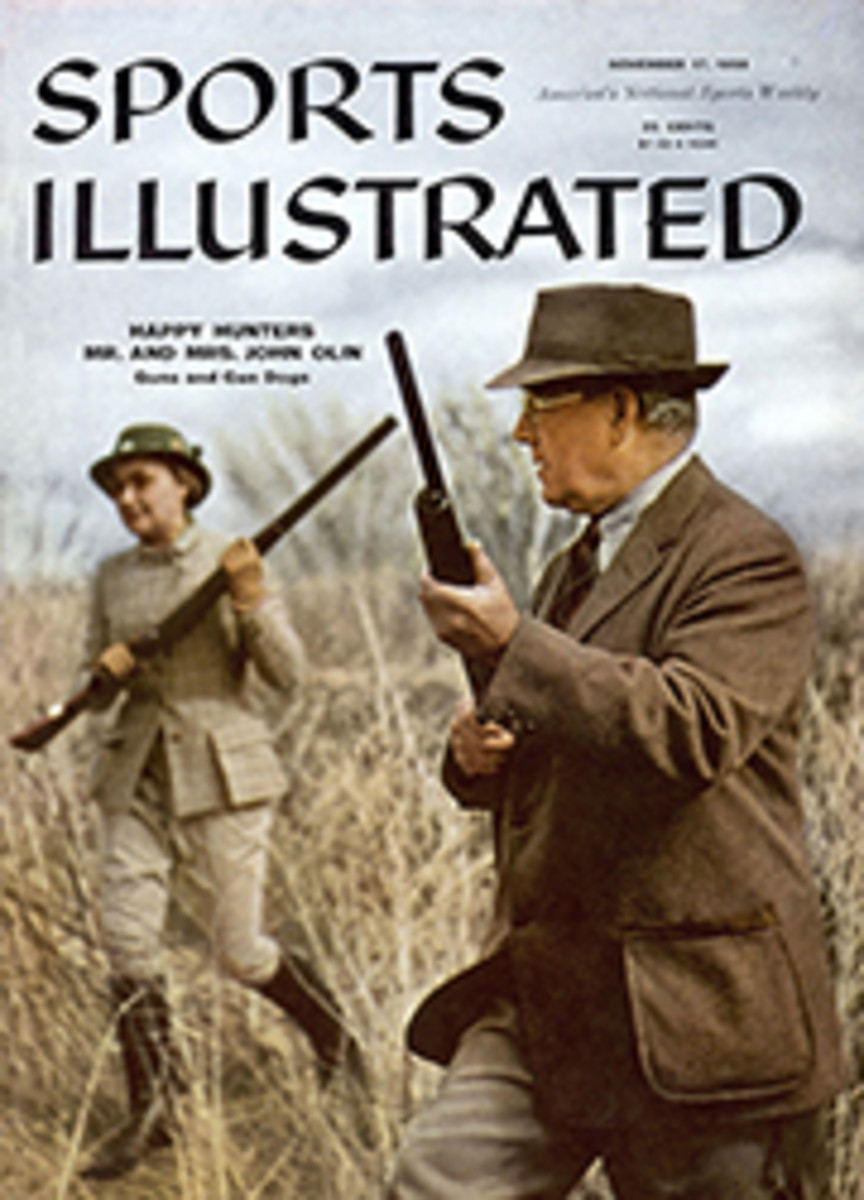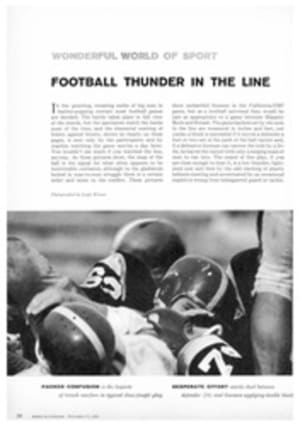
Who'll play follow the liter?
The men who control international auto racing met privately the other day to choose the rules that builders of the world's most important road racing cars must follow in two years' time. For two days they debated the question heatedly behind the imposing Pall Mall facade of London's Royal Automobile Club. When they announced their decision, there was unprecedented tumult in the RAC's august halls, for the ruling meant, in effect, that the new cars would be decidedly puny ones. If a similar step were taken in boxing, it would mean that all classes above the lightweight level, say, would be disqualified, that the lightweight champion would be declared the world's best boxer by an all-powerful committee. Floyd Patterson, Ray Robinson and Carmen Basilio would be outlawed; Joe Brown would perforce be the best boxer in the world. The adage about a good big one is as true of racing engines as it is of boxers.
In road racing the heavyweight cars (in the sense that they are of the highest caliber and thus provide the best sport) are those built to a set of rules called Formula I. They are commonly known as Grand Prix cars. For more than 50 years they have been the Thoroughbred racers of the international sport. They have given the great drivers—Nuvolari, Caracciola, Ascari, Fangio, to name some of the most eminent—their supreme tests. The formula governing engine size has been changed frequently over the years, but usually the cars have had such power that they have exacted the utmost in driving skill. Racing's oldtimers speak of the sensationally powerful and fabulously fast prewar Mercedes and Auto Union Grand Prix cars (and the champions who drove them) with the awe and affection that boxing's oldtimers reserve for Jack Dempsey. Only a handful of drivers could do those cars justice.
Now the rulers of road racing—members of the Commission Sportive Internationale of the Fédération Internationale de l'Automobile—have chosen a formula that threatens to make Grand Prix racing a second-rate sport. The current rule limiting maximum piston displacement to 2,500 cubic centimeters (2½ liters) has already permitted some distinctly underpowered racers (because of their extreme lightness) to challenge and even surpass the full-scale English Vanwalls and Italian Ferraris on some twisty courses. Under the new formula voted in at London, engines must be a full 1,000 cc. smaller than today's maximum—the size of current Formula II engines. Formula II racing is today chiefly in secondary events run off with the major Grand Prix races.
The men in London also decreed that the new cars must have reserve braking systems, should the primary systems fail; safer fuel tanks; anti-roll bars; and self-starters. Of more importance, they ruled that the cars must weigh at least 500 kilograms—approximately half a ton—including lubricants and coolants, but not counting fuel.
Eight nations were represented at the meeting: the U.S., Britain, Germany, Italy, France, Belgium, The Netherlands and Monaco. The new formula was voted over the strong opposition of Britain and Italy, which are the only nations building Grand Prix cars today, and the U.S. This powerful minority immediately got permission to form a subcommittee to work out a special intercontinental formula with a much larger engine size—a move with far-reaching implications for the U.S., and the sport, as we shall see.
BIG YEAR FOR BRITAIN
Britain, enjoying its greatest Grand Prix successes in history, sent its best drivers and foremost builders to plead for an extension of the current formula, which has been in force for five years. Mike Hawthorn, who won the world driver championship (in Ferraris), and Stirling Moss, the driver he defeated by one point; Tony Vandervell, builder of the Vanwalls, which won six races, and Charles Cooper, builder of the little Coopers, which won two—all testified to no avail. Italy's No. 1 builder, Enzo Ferrari, sent his views in writing. It is known that he advocated an intercontinental 3-liter formula for races between European and American cars and, as a compromise, a 2-liter car with a minimum weight limit of 1,320 pounds as a secondary class. Charles Moran Jr., chairman of the Automobile Competition Committee for the United States (America's voice in the CSI), joined the British and Italian delegates in the futile attempt to convince the opposition that a smaller-engined and thus slower car would not necessarily make the sport safer.
Government pressures at home to do something about safety undoubtedly led to the ganging up on the British, Italians and Americans—and not just because Grand Prix racing has had one of its rare bad years for driver fatalities (with Britain's Peter Collins and Stuart Lewis-Evans and Italy's Luigi Musso killed).
Memories of the Le Mans holocaust of 1955 and the Mille Miglia disasters of 1957 are still vivid in Europe. The fact that they were caused by sports cars, not Grand Prix cars, seems to have made little difference in London. Paradoxically, the championship sports cars, at 3 liters, have even bigger and more powerful engines than current Grand Prix cars.
Nevertheless, France's Augustin Perouse, president of the CSI and a member for 30 years, made it clear before the meeting that he was seeking a drastic reduction in engine size. After the decision was announced he said Grand Prix racing would not have been allowed in France next year and possibly would have been stopped in Germany later, if a major change had not been voted.
UPROAR IN THE RAC
British manufacturers, drivers, race officials and reporters raised an angry roar of disapproval upon hearing the news, and everybody in the staid old RAC building was suddenly trying to speak or shout at once. The elegant Italian delegate, Count Giovanni Lurani Cernuschi, contradicted Perouse, whose version of the voting implied that only Britain had opposed the change. Cernuschi, better known as Johnny Lurani, a dashing driver of the 1930s, explained to reporters and friends who suddenly swirled around him that Britain and Italy had even tried to compromise on 2 liters. To Lurani a 1½-liter racer was "not a man's car."
Mike Hawthorn, Britain's first world champion driver and leader of an apparently inexhaustible pack of British stars, bitterly criticized the change as "the most retrograde step taken in the history of motor racing." He snapped: "Plenty of drivers can race at 120 mph, but there are not many who can race at 140 mph. Drivers should have to learn to achieve this standard. As for safety, the lighter the car is, the easier it is to handle and the safer it is to drive." Hawthorn was unwilling to make public his specific testimony before the CSI but could not resist groaning, "They should leave the formula alone."
None of the British principals would concede that the new formula would make racing any safer. On the contrary, they argued that it would in fact make racing more dangerous. Since the speed differential between drivers of varying merits will be decreased, the less experienced will be tempted, they said, to drive beyond their capacities. In any case, many drivers believe that they can get out of trouble more easily with more power in hand.
The British were especially irate over the matter of a minimum weight. Famous for their achievements in light chassis construction (the lighter the car relative to its power, the faster it goes), they consider the minimum weight rule a roadblock to further development in this aspect of design. The smaller British Grand Prix cars are already beneath the 500-kilogram limit; all the 1½-liter Formula II racers weigh considerably less.
Mike Hawthorn felt that safety would be better served through alterations in racing circuits, not the cars. "I do not suggest destroying the character of the circuits," he said, "but I think drivers are entitled to a reasonable chance of getting away with it if they go off the road at a corner. A little work is definitely needed on various corners; for instance, the place where Musso went off in this year's French Grand Prix." (Musso was fatally injured in that accident.)
By their insistence on a very small engine, the majority delegates may well have thrown out the baby with the bath water. Britain's Aston Martin chief, David Brown, who plans to enter Grand Prix racing under the current formula, declared, "We shan't build a 1½-liter car." Tony Vandervell was not sure he wanted to continue at all. Dean Delamont, one of the British delegates to the meeting, said, "We want motor racing to be the ultimate in glamorous spectacle and speed, a prestigious sport. This is a negative step."
Perhaps the desire for glamour and speed will yet be fulfilled through the new intercontinental formula. The approval of Charles Moran's motion for a special subcommittee to develop such a rule gave it official status; this will not be an outlaw movement facing formidable odds. The U.S., which has no small racing engines of note and is not likely to develop any, thereby receives a chance to enter international CSI racing in an important way with engines suited to its resources. For a starter, Moran's committee is thinking of the 4.2-liter Meyer-Drake Offenhauser engine, which dominates the Indianapolis "500." It is very difficult to adapt to road racing, as Briggs Cunningham discovered when he put one into one of his Le Mans sports cars; its "severe power impulses" invite clutch trouble, as the Indy car owner Jack Zink points out, and cars so powered are slow off the mark. Still, it is the best the U.S. has. And Moran is not thinking exclusively of road racing. He suggests the possibility of out-and-out track racing on the intercontinental program, and he will take a close look at the new high-speed track that is under construction at Daytona Beach, Fla. as one of several possible sites. The dramatic track races won by Indianapolis cars at Monza, Italy this year and last gave Europeans a taste of speed racing of a kind they had all but forgotten. The Europeans, significantly, made a substantial and effective effort at Monza this year after largely boycotting the event in 1957. The U.S. will have its first big Grand Prix race since 1937 next March at Sebring, Fla., a further stimulus to American interest in worldwide racing.
A NATIONAL NEED
Moran's group will begin at once to sound out the leaders in American racing—officials of the U.S. Auto Club and NASCAR, chassis builders like Frank Kurtis, engine men at Meyer-Drake. "We want to talk with everybody who might be concerned," Moran said. "We would like to work out a detailed formula to present to the subcommittee by spring. I think this will fill a national need—and the needs of others who feel that 1½ liters is too small an engine to represent championship motor racing at its best."
If something of this kind is not done, some of the world's best drivers may not even want to race. Stirling Moss, probably the best driver of all despite his defeat by Mike Hawthorn this year, was considering his retirement in 1961 if the 1½-liter engine reigns. He didn't fancy being like a "runner running with great big boots on."
TWO PHOTOS
2.5
British Vanwall, winner of six 1958 races, is the champion Grand Prix car under the current 2.5-liter engine formula.
Over-all length: 14 feet
Height: 3 feet 9¼ inches
Top speed: 170 miles per hour
1.5
British Cooper, champion Formula II car, shows how unimpressive next Grand Prix cars may look under 1.5-liter rule.
Over-all length: 12 feet
Height: 2 feet 10 inches
Top speed: 145 miles per hour

